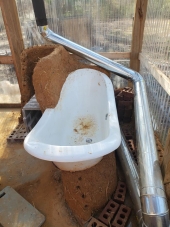
 4
4




 6
6




regards, Peter

 5
5




For all your Montana Masonry Heater parts (also known as) Rocket Mass heater parts.
Visit me at
dragontechrmh.com Once you go brick you will never go back!
 3
3




thomas rubino wrote:Very common Liam.
Quite a few first/second, and even third burns have drips.
Covering the flue is very important to keep the cooling air traveling out of your chimney.
Exposed pipes radiate too much heat.
The wood you are burning can also be a source of moisture.
Tape your pipe joints with metal tape, cob over all that should be.
If you used a mortar and had wet bricks, all need to be dried.
How about some pictures of your build.




 6
6




For all your Montana Masonry Heater parts (also known as) Rocket Mass heater parts.
Visit me at
dragontechrmh.com Once you go brick you will never go back!
 4
4




thomas rubino wrote:Hey Liam;
Very clean-looking build you have there.
Peter thought it looked like a 6" system, I think it looks larger like maybe an 8".
I would like to see the transition area better. Is that one continuous pipe or two legs?
How much pipe do you have, not counting the vertical rise?
At this point before cobbing, you could easily change from pipes to a bell system.
Bells are so much easier to run than a piped system.
I have an 8" piped system that started with an 8" J-Tube feeding it. Worked great!
That same piped system is now fed by a 6" batchbox, it also works great, but only once it is completely warmed up.
It does need to use its 4" bypass anytime it is not warmed up.
If you are happy with your draft then start cobbing over those pipes, they are a part of the condensation issue.
 5
5




 3
3




Liam Alderdice wrote:
thomas rubino wrote:Hey Liam;
Very clean-looking build you have there.
Peter thought it looked like a 6" system, I think it looks larger like maybe an 8".
I would like to see the transition area better. Is that one continuous pipe or two legs?
How much pipe do you have, not counting the vertical rise?
At this point before cobbing, you could easily change from pipes to a bell system.
Bells are so much easier to run than a piped system.
I have an 8" piped system that started with an 8" J-Tube feeding it. Worked great!
That same piped system is now fed by a 6" batchbox, it also works great, but only once it is completely warmed up.
It does need to use its 4" bypass anytime it is not warmed up.
If you are happy with your draft then start cobbing over those pipes, they are a part of the condensation issue.
This is a 6 inch system with just over 6m of flu in the bench and around 4m of vertical flu out the roof. The top couple metres in the loft will be insulated. I've installed a Y inline with the vertical flu incase I need to preheat it (Venturi?)
I understand how the system works but calculating surface areas and knowing what I need to subtract confuses me so would love some help there!
Unfortunately I can't really afford to buy new materials right now so if the cob doesn't work I'll have to build a bell system. Or install a bypass if that'll work.
I'll add some more images
 5
5




Liam Alderdice wrote:I understand how the system works but calculating surface areas and knowing what I need to subtract confuses me so would love some help there!
regards, Peter

|
After three months of being pooless the hair and skin on this tiny ad is glorious!
Learn Permaculture through a little hard work
https://wheaton-labs.com/bootcamp
|




